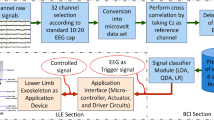Abstract
The research application based on BCI (Brain-Computer Interface) technology is increasing significantly at the present time. The preliminary focus for all BCI related activities is the feature extraction and classification of raw EEG (Electroencephalogram) signals to determine the tasks associated with it. In the beginning, many channels are used to record the signals. Analysis of every channels during performing task makes the classification system very heavy due to the presence of various not so useful information. Therefore, in the present work, only three out of sixty channels from a MI (Motor Imagery)-based EEG database are selected and the effect of reducing channels are discussed. Two feature extraction techniques viz. cross-correlation and wavelet energy have been used. Four MI tasks have been identified using LDA (Linear Discriminate Analysis) classifier from the obtained feature sets. The best average classification accuracy for binary class from three subjects found as 87.50%, 88.89% and 80.95%, respectively. Further, a comparative study with the published work has been performed and it has been observed that the proposed classification methods provide satisfactory results. After successful classification of the EEG signals, one assistive robotic device called lower limb exoskeleton has been triggered with the different MI events. Hence, the present study enhances the recent trends of BCI by implementing the feasibility of a minimum set of channels for MI related BCI application exclusively.




Similar content being viewed by others
References
K.J. Panoulas, L.J. Hadjileontiadis, S.M. Panas, Brain-computer interface (BCI): types, processing perspectives and applications (Multimedia services in intelligent environments Springer, Berlin, Heidelberg, 2010), pp. 299–321
G. Pfurtscheller, F.L. Da Silva, Event-related EEG/MEG synchronization and desynchronization: basic principles. Clin. Neurophysiol. 110(11), 1842–1857 (1999)
C. Wang, X. Wu, Z. Wang, Y. Ma, Implementation of a brain-computer interface on a lower-limb exoskeleton. IEEE Access 6, 38524–38534 (2018)
A.B. Zoss, H. Kazerooni, A. Chu, Biomechanical design of the Berkeley lower extremity exoskeleton (BLEEX). IEEE/ASME Trans. Mechatron. 11(2), 128–138 (2006)
REX BIONICS, https://www.rexbionics.com/product-information/, last Accessed from 2021/02/04
J. Zhang, M. Wang, A survey on robots controlled by motor imagery brain-computer interfaces. Cognitive Robot. 1, 12–24 (2021)
M.S. Al-Quraishi, I. Elamvazuthi, S.A. Daud, S. Parasuraman, A. Borboni, EEG-based control for upper and lower limb exoskeletons and prostheses: a systematic review. Sensors. 18(10), 3342 (2018)
G. Roy, D. Nirola, S. Bhaumik, An Approach towards Development of Brain Controlled Lower Limb Exoskeleton for Mobility Regeneration. in 2019 IEEE Region 10 Symposium (TENSYMP), IEEE (2019) pp. 385–390
S. Kumar, A. Sharma, T. Tsunoda, Brain wave classification using long short-term memory network based OPTICAL predictor. Sci. Rep. 9(1), 1–13 (2019)
D. Xiao, Z. Mu, J. Hu, Classification of motor imagery EEG signals based on energy entropy. in: 2009 International Symposium on Intelligent Ubiquitous Computing and Education, IEEE (2009) pp. 61–64
G. Roy, A.K. Bhoi, S. Bhaumik, A comparative approach for mi-based eeg signals classification using energy Power and Entropy. IRBM (2021). https://doi.org/10.1016/j.irbm.2021.02.008
N. K. Verma, L. V. S. Rao, S. K. Sharma, Motor imagery EEG signal classification on DWT and crosscorrelated signal features. in 2014 9th International Conference on Industrial and Information Systems (ICIIS), IEEE (2014), pp. 1–6
S. Siuly, Y. Li, Improving the separability of motor imagery EEG signals using a cross correlation-based least square support vector machine for brain-computer interface. IEEE Trans. Neural Syst. Rehabil. Eng. 20(4), 526–538 (2012)
S. Chandaka, A. Chatterjee, S. Munshi, Cross-correlation aided support vector machine classifier for classification of EEG signals. Expert Syst. Appl. 36(2), 1329–1336 (2009)
J. Choi, K.T. Kim, J.H. Jeong, L. Kim, S.J. Lee, H. Kim, Developing a motor imagery-based real-time asynchronous hybrid BCI controller for a lower-limb exoskeleton. Sensors. 20(24), 7309 (2020)
Z. Qiu, J. Jin, H.K. Lam, Y. Zhang, X. Wang, A. Cichocki, Improved SFFS method for channel selection in motor imagery based BCI. Neurocomputing 207, 519–527 (2016)
J. Jin, Y. Miao, I. Daly, C. Zuo, D. Hu, A. Cichocki, Correlation-based channel selection and regularized feature optimization for MI-based BCI. Neural Netw. 118, 262–270 (2019)
G. Roy, S. Bhaumik, MI EEG signal classification for lower limb operation based on cross-correlation and wavelet features. in Proceedings of International Conference on Industrial Instrumentation and Control (Springer, Singapore, 2022), pp. 247–254
BCI Competition III, Data sets IIIa, http://www.bbci.de/competition/iii/#data_set_iiia, last Accessed from 2019/11/20
R.O. Duda, P.E. Hart, D.G. Stork, Pattern Classification, 2nd edn. (John Wiley & Sons, New Delhi, 2006)
Funding
The authors declare that no funds, grants, or other support were received during the preparation of this manuscript.
Author information
Authors and Affiliations
Corresponding author
Ethics declarations
Conflict of interest
The authors have not disclosed any competing interests.
Additional information
Publisher's Note
Springer Nature remains neutral with regard to jurisdictional claims in published maps and institutional affiliations.
Rights and permissions
About this article
Cite this article
Roy, G., Bhaumik, S. Classification of MI EEG Signal Using Minimum Set of Channels to Control a Lower Limb Assistive Device. J. Inst. Eng. India Ser. B (2022). https://doi.org/10.1007/s40031-022-00783-x
Received:
Accepted:
Published:
DOI: https://doi.org/10.1007/s40031-022-00783-x




